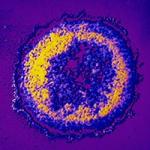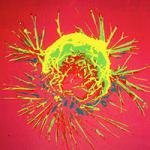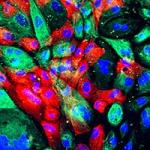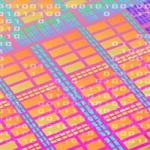
Research Topics
The research conducted in this section is focused on the body’s capabilities of producing reactive oxygen species (ROS) and the roles of ROS in innate anti-microbial and inflammatory processes. This program originated with interests in the NADPH oxidase of phagocytes (phox system), the importance of which is evident in chronic granulomatous disease where inherited defects in ROS production render patients susceptible to bacterial and fungal infections and dysregulated inflammatory responses. Early work in this program identified phox genes affected in chronic granulomatous disease and characterized oxidase functional domains and signaling intermediates involved in its assembly and activation.
Current efforts are focused on homologous Nox family NADPH oxidases that produce ROS in a variety of tissues. ROS production by these enzymes is thought to serve diverse functions, including hormone and extracellular matrix biosynthesis, oxygen sensing, and cellular signaling involved in processes including apoptosis, cell senescence, and cellular responses to growth factors, hormones, or immune cytokines. Growing evidence suggests several of these novel oxidases also function in host defense and inflammatory responses, as they demonstrate high expression in epithelial cells, appear to be aimed toward the external environment, and support the activity of anti-microbial peroxidases on mucosal surfaces.
Nox family oxidases with potential host defense and inflammatory roles include hydrogen peroxide-generating dual oxidases (Duox1 and Duox2) detected in airways, exocrine glands, and the gastrointestinal tract and oxidases of the colon, kidney, and vascular cells (Nox1 and Nox4). Several oxidases are induced or activated by pro-inflammatory cytokines, by host recognition of pathogen-associated microbial patterns and in adaptive immune responses.
This group uses a variety of experimental approaches to explore mechanisms of deliberate ROS production and the biological and pathological consequences of this activity, ranging from studies in genetically-modified animal models or tissue and cell culture systems to work on protein structure-function relationships involved in regulated assembly and activation of ROS generators. Ongoing projects include:
- Characterization of the Nox1-based multi-component oxidase similar to the phagocytic system that is responsive to receptor activation
- Elucidation of mechanisms of subcellular targeting and ROS generation by Nox and Duox isozymes
- Investigations of responses of Duox and Nox4 to microbial infection and in the adaptive immune system
- Studies on the targets of ROS involved in redox-based cellular signaling
- Studies on NADPH oxidase single nucleotide polymorphisms (SNPs) in relation to infectious and inflammatory diseases
- Studies on roles of Nox4 in the TGF-beta-driven epithelial-to-mesenchymal transition and cell migration/metastasis of breast epithelial cells
The migration of MDA-MB-231 metastatic breast epithelial cells into denuded areas of confluent cultures (“wound healing”) is promoted by transforming growth factor-beta when compared with untreated (UT) cultures. This involves direct induction of Nox4 by the transcription factor SMAD3, since dominant negative SMAD3 or SMAD3 inhibitors block elevations of Nox4 mRNA and protein and production of reactive oxygen species. The Nox4-derived oxidants, in turn, drive EMT-related events involved in wound healing including fibronectin expression and cell migration, as confirmed by the inhibitory effects of dominant negative Nox4 or Nox4 silencing by short hairpin RNA (shRNA).
Biography
Dr. Leto received his Ph.D. in biochemistry from the University of Virginia for studies on mechanisms of cell membrane assembly. He followed this work with postdoctoral studies at Yale University on membrane cytoskeleton interactions. Dr. Leto joined NIAID in 1988 and became a senior investigator in the Laboratory of Host Defenses in 1996.
Special Interest Groups: Cell Biology, Structural Biology, Free Radical/Oxygen Club
Selected Publications
- Donkó Á, Sharapova SO, Kabat J, Ganesan S, Hauck FH, Bergerson JRE, Marois L, Abbott J, Moshous D, Williams KW, Campbell N, Martin PL, Lagresle-Peyrou C, Trojan T, Kuzmenko NB, Deordieva EA, Raykina EV, Abers MS, Abolhassani H, Barlogis V, Milla C, Hall G, Mousallem T, Church J, Kapoor N, Cros G, Chapdelaine H, Franco-Jarava C, Lopez-Lerma I, Miano M, Leiding JW, Klein C, Stasia MJ, Fischer A, Hsiao KC, Martelius T, Seppänen MRJ, Barmettler S, Walter J, Masmas TN, Mukhina AA, Falcone EL, Kracker S, Shcherbina A, Holland SM, Leto TL, Hsu AP. Clinical and functional spectrum of RAC2-related immunodeficiency. Blood. 2024;143(15):1476-1487.
- Hsu AP, Korzeniowska A, Aguilar CC, Gu J, Karlins E, Oler AJ, Chen G, Reynoso GV, Davis J, Chaput A, Peng T, Sun L, Lack JB, Bays DJ, Stewart ER, Waldman SE, Powell DA, Donovan FM, Desai JV, Pouladi N, Long Priel DA, Yamanaka D, Rosenzweig SD, Niemela JE, Stoddard J, Freeman AF, Zerbe CS, Kuhns DB, Lussier YA, Olivier KN, Boucher RC, Hickman HD, Frelinger J, Fierer J, Shubitz LF, Leto TL, Thompson GR 3rd, Galgiani JN, Lionakis MS, Holland SM. Immunogenetics associated with severe coccidioidomycosis. JCI Insight. 2022;7(22).
- Boudreau HE, Korzeniowska A, Leto TL. Mutant p53 and NOX4 are modulators of a CCL5-driven pro-migratory secretome. Free Radic Biol Med. 2023;199:17-25.
- Mason H, Rai G, Kozyr A, De Jonge N, Gliniewicz E, Berg LJ, Wald G, Dorrier C, Henderson MJ, Zakharov A, Dyson T, Audley J, Pettinato AM, Padilha EC, Shah P, Xu X, Leto TL, Simeonov A, Zarember KA, McGavern DB, Gallin JI. Development of an improved and specific inhibitor of NADPH oxidase 2 to treat traumatic brain injury. Redox Biol. 2023;60:102611.
- Ma WF, Boudreau HE, Leto TL. Pan-Cancer Analysis Shows TP53 Mutations Modulate the Association of NOX4 with Genetic Programs of Cancer Progression and Clinical Outcome. Antioxidants (Basel). 2021;10(2).
Related Scientific Focus Areas


Microbiology and Infectious Diseases
View additional Principal Investigators in Microbiology and Infectious Diseases



This page was last updated on Friday, August 23, 2024